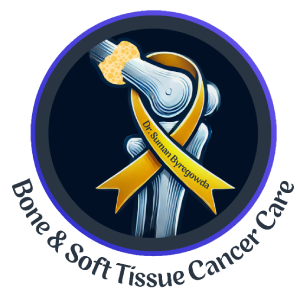

You need to consult an orthopaedic oncologist for osteosarcoma because they specialize in bone cancers. They are experts in diagnosing, treating, and managing bone cancer, particularly osteosarcoma, and can offer treatments like surgery, chemotherapy, and radiation. They know how to save the limb, control the cancer, and make sure you get the best care possible.
Osteosarcoma is a type of bone cancer that starts in the cells that form bones. It usually forms in the long bones (arms or legs) and is the most common type of bone cancer in children and young adults. It can be aggressive and spread to other parts of the body if not treated early.
Osteosarcoma mostly affects young people, especially teenagers between 10 and 20 years old. It can also affect people over 60, but it’s much less common in adults.
The exact cause of osteosarcoma is not fully known, it happens with no obvious reason. It does not run in family so sibling and immediate family are not at risk
Yes, a needle biopsy is needed to confirm the diagnosis of osteosarcoma. A small needle is used to take a tissue sample from the tumor to check for cancer cells. This helps doctors decide the best treatment options.
Yes, in many cases, it’s possible to save the limb through limb-salvage surgery, which removes the tumor but keeps the bone and limb. If the tumor is very large or in a difficult-to- remove area, amputation may be necessary, but doctors try their best to preserve the limb.
Yes, osteosarcoma can be cured if caught early and treated properly with surgery and chemotherapy. The chances of a cure depend on factors like the size and location of the tumor, whether it has spread, and how well the treatment works. Early detection and treatment give the best chances for a cure. Cure rate in early diagnosed cases varies from 60-80 percent.
Osteosarcoma can come back after treatment, which is called a recurrence. The risk is highest within the first few years after treatment. Regular follow-up care and scans are important to check for any signs of recurrence. High chance of recurrence seen in large volume disease, if cancer had already spread to other parts of the body and not responding well for chemotherapy.
Yes, many people who are treated for osteosarcoma can go on to live normal lives, especially if the cancer is caught early and treated effectively. They may need some rehabilitation and physical therapy after surgery, particularly if there was a limb-salvage procedure, but many people return to school, work, and normal activities.
No, osteosarcoma is not contagious, so it will not spread to family members or caregivers. It is a cancer that starts from changes in the person’s own cells, and it cannot be passed from person to person.
Osteosarcoma is a type of bone cancer that usually requires surgery as the main treatment. This is because the cancer typically forms a tumor in the bone, and the most effective way to remove it is by surgically excising (removing) the tumor However, chemotherapy (using medicine to kill cancer cells) is given before and after surgery to shrink the tumor and kill any remaining cancer cells.